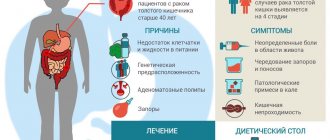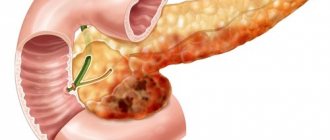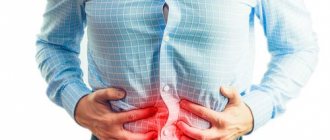Neurotropic antispasmodics
The mechanism of action of drugs from this group is associated with blocking the conduction of excitation from nerve endings or ganglia to the smooth muscle cells of internal organs.
Most drugs are M-anticholinergic drugs. The antispasmodic effect is associated with blocking M-cholinergic receptors in the human body. These receptors are responsible for the secretion of hydrochloric acid in the stomach, the functioning of the salivary and sweat glands, increase the tone of smooth muscles in the digestive tract, and reduce the heart rate. When they are blocked, the muscles of the gastrointestinal tract relax, especially the upper sections (esophagus, sphincter of Oddi, stomach, gall bladder). M-cholinergic receptors are practically not found in the intestines, so most drugs in this group do not have an effect on abdominal pain caused by diseases of the lower digestive tract, which limits their use.
- Atropine sulfate (Atropine). It is a plant alkaloid of a number of poisonous plants (henbane, datura). It affects M-cholinergic receptors located on the periphery and in the central nervous system. It affects the functioning of a large number of organs (digestive system, respiratory, cardiovascular, endocrine glands, brain, iris, etc.). Use is limited by the frequent development of adverse reactions from various organs and systems. It has a low range of therapeutic doses, which increases the risk of overdose.
- Platiphylline hydrotartrate (Platifillin). Plant alkaloid of ragwort. It is 5 times weaker than atropine in its effect on the gastrointestinal tract. Causes less side effects compared to atropine. Used in emergency care to relieve pain spasms.
- Hyoscine butyl bromide (Buscopan, Neoscopan). One of the most studied antispasmodics, which has an optimal effectiveness-safety ratio. The drug acts on the subtypes of M-cholinergic receptors, which are located in the gastrointestinal tract, and therefore does not affect the central nervous system, bronchi and blood vessels. The antispasmodic effect on the gastrointestinal tract is 44 times stronger than the effect of drotaverine. The main application is spastic conditions of the upper digestive tract (esophagus, stomach). When taking the drug, dry mouth, drowsiness, increased heart rate and other atropine-like effects that do not require special treatment may rarely occur.
- Metacin . Does not penetrate the blood-brain barrier. Reduces the secretion of hydrochloric acid in the stomach. Reduces the tone of the upper digestive tract. Causes atropine-like side effects (dry mouth, paralysis of accommodation, etc.). It is used mainly for the treatment of gastric ulcers as part of complex therapy.
- Chlorosyl . It differs little from Metacin in pharmacological action and side effects.
Antispasmodics for children
In childhood, functional disorders of the gastrointestinal tract such as spastic dyskinesia are more common. All parts of the digestive system (gallbladder, intestines, stomach, etc.) are subject to a spastic state. In children, both groups of antispasmodics are used to treat such conditions, but age restrictions and the characteristics of the child’s body at different age intervals are taken into account (immaturity of some liver enzymes up to 12 years of age, stomach acidity at an early age and in older children, etc.), the drugs are prescribed strictly according to indications.
The following antispasmodic drugs are approved for use in children:
Antispasmodics in the treatment of intestines
Antispasmodics are special drugs whose action is aimed at relieving intestinal spasms (its smooth muscles). Most often, spasms occur due to various organ diseases, PMS, or poor nutrition. Antispasmodics have a relaxing effect on the intestinal muscles and thereby reduce pain. Most often, spasms occur with an ulcer in any part of the intestine or problems with the biliary system.
Main reasons for use
Pain in one of the intestinal sections can occur not only due to any pathology of the organs; various, quite everyday problems are also possible:
- constipation;
- diarrhea;
- bloating;
- poisoning with low-quality products or toxins.
In this case, many people try, of course, to solve the main problem first, but not everyone takes antispasmodics. There is no need to endure pain! If a person is afraid that excessive use of medications will negatively affect health, then it is better to give preference to those medications that contain a large number of natural ingredients (herbs).
Classification of medications
Antispasmodics are usually divided into groups depending on various criteria. Let's look at the most important of them.
Origin:
- artificially derived drugs;
- natural (mint, chamomile, oregano, belladonna, lovage, tansy).
Natural antispasmodics are traditionally considered more harmless to the intestines, they have fewer contraindications, but they should still be taken with caution, since there are still certain side effects.
Mechanism of action:
- neurotropic. Such drugs affect the neurons that transmit impulses to the intestinal muscles. (buscopan, atropine, aprofen, scopolamine);
- myotropic. They act directly on the muscle fibers of the corresponding organ, relaxing them. Almost all such drugs for the intestines are based on No-shpa (mebeverine, halidor, hymecromone, papaverine).
In other words, antispasmodics make changes to the functioning of the intestinal muscles themselves or block the transmission of nerve impulses to it.
Complex medications are often used to help not only relieve spasm at the site of its occurrence, but also help relax tense heart muscles and relieve spasms of the arteries and blood vessels of the brain. (Baralgin, Spazmalgon). They contain not only components that relieve spasms, but also painkillers.
Release form:
- tinctures (mint);
- suppositories (papaverine);
- granules for diluting solutions (plantacid);
- drops (valoserdin);
- capsules (Sparex);
- tablets (often antispasmodics are produced this way - no-shpalgin, driptan, spasmonet-forte, besalol);
- ampoules (dibazol, no-spa) - intended for subcutaneous administration (intravenous or intramuscular injections).
Contraindications for use
Absolutely all antispasmodics have a number of contraindications. The interesting thing is that it doesn’t matter at all whether these are medications for stomach pain, headaches or any other spasm. Contraindications will be absolutely the same due to the fact that the drugs have an effect on the entire body as a whole.
Antispasmodics are strictly prohibited for use when:
- Crohn's disease;
- tuberculosis;
- some types of colitis;
- microbial infections of any part of the gastrointestinal tract.
It is also necessary to consult a doctor before taking the drug if you have any pathologies of internal organs or gastrointestinal diseases.
Before use, it is necessary to carefully study the composition of the drug, since in medical practice there have often been cases when a patient has an individual intolerance to one of the components included in the composition. In this case, special attention should be paid to medicines based on herbal components. They are even more likely to cause allergic reactions than synthetic drugs.
Additional recommendations
As the instructions and advice of many doctors say: “In some cases, a drug should be taken only if the benefit from its effect significantly outweighs the possible risk.” This applies in particular to the use of such medications during pregnancy, lactation and children.
If we talk about breastfeeding, then while taking such medications it is necessary to stop breastfeeding until the remnants of the drug are removed from the blood. When it comes to taking the drug by children, it is necessary to strictly follow the instructions, which stipulate the exact specific dosage for each age.
All the same, in all these cases it is necessary to consult a doctor and discuss each specific case separately.
The most risky drugs
Doctors separately identify two drugs that have many more contraindications than others and therefore should be taken with extreme caution:
- Papaverine. As carefully as possible, slowly, in small doses and only under the supervision of a doctor, it can be used by elderly and weak patients, as well as those suffering from various pathologies of the kidneys, liver, adrenal glands, prostate gland, bladder;
- Drotaverine. It is almost always prohibited for use in cases of atherosclerosis, renal or liver failure, cardiac disorders, and pressure surges. The drug can also have a negative effect on concentration, therefore, during the period of its use, it is not recommended to drive or engage in any other dangerous activity that requires a person to concentrate, react well and concentrate.
The same can be said about other drugs that contain the above components.
Myotropic drugs
These products are considered quite gentle and were developed specifically for relatively frequent use. Yes, they do not cause any special complications, but at the same time they should not be overused. Nevertheless, such medications are an ideal solution for eliminating menstrual pain, cramps and constipation (especially common in older people).
Their main effect is to relax the muscles precisely at the location of the spasm itself.
The most popular among this group of drugs is Papaverine. With long-term use, it can have a relaxing effect on the abdominal organs, as well as on the heart muscle, thereby helping to prevent heart attacks and strokes.
Folk remedies
If the spasms are not too pronounced, then it is recommended to use more gentle means, namely herbal preparations and tinctures, which can also be purchased at the pharmacy:
- dill and dill water. It not only has a choleretic effect, but also helps solve the problem of bloating and promotes the normal discharge of accumulated gases. It is used even during pregnancy or for small children (for colic in newborns);
- sagebrush. Not only relieves spasms of all parts of the gastrointestinal tract, but also helps improve digestion, the functioning of internal organs, and improves appetite;
- peppermint. Indicated not only for spasms, but also for vomiting, nausea, stomach upsets, and inflammation of the mucous membrane. It has not only antispasmodic, but also antiseptic properties.
Main signs of overdose
There are still cases of overdose with such drugs. The most dangerous thing is that this does not mean that the person has exceeded the daily allowable limit. Sometimes in individual cases, in simple terms, that dose is more than enough for the body to become oversaturated. In such a case, you need to rinse your stomach and consult a doctor as soon as possible.
Overdose can manifest itself in different ways:
- allergies (skin rashes, itching, Quincke's edema);
- nausea, vomiting, constipation, diarrhea;
- central nervous system disorder (convulsions, increased agitation, anxiety);
- cardiac dysfunction (tachycardia, decreased blood pressure, arrhythmia);
- slower reaction to what is happening around;
- headache, dizziness;
- dry mouth, chills.
All these signs can appear either individually or simultaneously in combination.
Additional instructions
When using these drugs, you should follow general recommendations that generally apply to absolutely all groups of medications:
- familiarize yourself with the storage conditions and comply with them;
- do not abuse medications (take strictly the amount prescribed by the doctor). As a last resort, you can increase the dose, but first check the instructions for the maximum daily amount;
- You must read the adverse reactions carefully. For some medications, these can be quite serious manifestations: hallucinations, drowsiness, lethargy, apathy, loss of clarity of vision, etc. If you do not familiarize yourself with these features in time, then this can be quite alarming. In addition, this is important if some serious event is planned or a person is involved in hazardous production.
Be careful!
In conclusion, it is still worth warning that antispasmodics help eliminate only an unpleasant symptom, but not the cause. If the pain recurs again, then you should consult a doctor as soon as possible, undergo an examination and find out the root cause. Otherwise, you can provoke a number of negative consequences - dulling the symptoms of a dangerous disease, bringing it to a more advanced stage, when it will be much more difficult to cure. Pain can indicate both minor illnesses (poisoning with expired products) and not very serious illnesses (even bowel cancer). Therefore, you need to be as attentive to your health as possible.
Neuromyotropic drugs
This group combines both activities. This effect is achieved through a combination of two or more active ingredients.
Herbal antispasmodic medications that block spasms. Some herbs have an effect on the intestinal muscles. Fennel, mint, belladonna, tansy, chamomile - these plants can remove spasms without side effects. Tablets, syrups and other preparations are made from them.
Antispasmodics based on herbal components are often prescribed to children. Pain in the intestines can manifest itself literally from infancy in the form of colic. They cause great discomfort to the baby. Colic is not generally considered a disease, but despite this, it causes anxiety, disrupts the child’s sleep and routine, directly affects the general condition, and, moreover, causes a lot of trouble for parents.
Suffering can often be reduced with the help of special syrups and suspensions. Syrups based on herbal ingredients are often prescribed. For example, Plantex blocks spasms in the intestines and is safe for children. The drug “Azulan” is made on the basis of chamomile, “Tanacehol” is based on tansy. There are other similar drugs.
Complex antispasmodic drugs
This is a complex of substances that relieves spasms and other symptoms. For example, these medications can reduce fever and relieve inflammation. They will not only eliminate the pain, but also remove the cause of the disease. Thus, “Pentalgin” is prescribed not only in case of spasm, but also in case of fever. "Spazmolgon" effectively helps with pain and is prescribed for high blood pressure. Novigan is prescribed for intestinal colic; it also helps with migraines and joint pain. The versatility of such drugs makes them very popular.
Many plants have the ability to relieve pain, which can be used as an alternative solution to pills. Return to contents
Antispasmodic herbs for the intestines
The safest assistants with no contraindications. Herbs have long been used in the treatment of pain. Before buying tablets or syrups, you can take herbal decoctions: chamomile, oregano, tansy, calamus, immortelle, oregano. They are sold at the pharmacy in the form of ready-made preparations. There are special medicinal teas for children that help with colic.
Antispasmodics (in gastroenterology)
Antispasmodics
- medications that reduce smooth muscle spasm.
Antispasmodics are the first choice drugs for the treatment of mild to moderate abdominal pain. Antispasmodics are used in the pharmacological treatment of patients with functional dyspepsia, patients with mild irritable bowel syndrome, biliary dyskinesias, as well as in the treatment of exacerbation of peptic ulcer disease before the appointment of Helicobacter pylori
, exacerbation of cholelithiasis before cholecystectomy, etc. Antispasmodics are also used as bronchodilators means for relieving spasms of bronchial muscles, for stimulating cardiac activity during the treatment of angina pectoris.
Myotropic antispasmodics used in gastroenterology
- medications with the active ingredient papaverine: papaverine, papaverine hydrochloride, papaverine MS, papaverine bufus
- medicine with complex active ingredient papaverine + bendazole: Papazole
- medications with the active ingredient drotaverine: Bespa, Bioshpa, Vero-Drotaverine, Droverin, droverine injection solution 2%, drotaverine, Drotaverine MS, Drotaverine forte, Drotaverine-AKOS, Drotaverine-KMP, Drotaverine-MIK, Drotaverine-STI, Drotaverine-UBF , Drotaverine-FPO, Drotaverine-ellara, drotaverine hydrochloride, drotaverine hydrochloride tablets 0.04 g, No-shpa, No-shpa forte, Nosh-bra, Spasmol, Spasmonet, Spasmonet forte, Spasmoverine, Spakovin
- medications with the active ingredient mebeverine: Duspatalin, mebeverine hydrochloride, Niaspam, Sparex
- medications with the active ingredient trimebutin: Neobutin, Neobutin Retard, Trimebutin SZ, Trimedat, Trimedat Valenta and Trimedat Forte.
- a selective antispasmodic that acts exclusively on the sphincter of Oddi, the sphincter of Lutkens and the biliary tract - hymecromone (trade name Odeston)
- antispasmodic intended for children aged two weeks (based on fruit extract and fennel oil): Plantex
- complex medicine Meteospasmil (antispasmodic alverine + antifoam simethicone)
- herbal medicine based on 9 herbs – Iberogast
The zones of distribution and severity of the antispasmodic effect are indicated in the table below (Minushkin O.N. et al.):
| Localization of spasm | Drotaverine | Papaverine | Hyoscine | Mebeverine | Pinaveria bromide | Otilonium bromide | Hymecromone | Trimebutine |
| Stomach | ++ | + | ++ | — | + | + | — | + |
| Biliary tract | ++ | + | ++ | + | + | ++ | ++ | ++ |
| Sphincter of Oddi | ++ | + | ++ | + | + | + | +++ | ++ |
| Intestines | ++ | ++ | + | +++ | ++ | ++ | — | +++ |
| Urinary tract | ++ | + | +/- | — | +/- | +/- | — | — |
| Uterus | ++ | + | — | — | — | — | — | — |
| Vessels | + | ++ | — | — | — | — | — | — |
Selective calcium channel blockers of gastrointestinal smooth muscle
The motor function of the gastrointestinal tract is under the control of numerous regulatory impulses from the central, peripheral and enteric nervous systems. In addition, motor activity is regulated by a large group of gastrointestinal peptides and bioactive molecules that act paracrinely and as neurotransmitters at the level of the Meissner and Auerbach nerve plexuses. At the final stage, the balanced functioning of the smooth muscle apparatus depends on the concentration of calcium in the cytoplasm of the myocyte and its movements across the cell membrane. An increase in calcium concentration is accompanied by the formation of the actin-myosin complex and contraction, and its decrease leads to relaxation of smooth muscles (Belousova E.A.). Calcium channel blockers close calcium channels in cell membranes, prevent calcium ions from entering the cytoplasm, and cause smooth muscle relaxation. In medicine, non-selective calcium blockers such as nifedipine, verapamil, diltiazem and others play an important role. However, this group of drugs acts primarily on the cardiovascular system; To achieve gastroenterological effects, high doses are required, which practically excludes their use in gastroenterology (Minushkin O.N., Maslovsky L.V.). To relieve spasms in the abdominal organs, selective blockers of smooth muscle calcium channels are used, which in therapeutic doses do not affect the cardiovascular system. Calcium channel blockers, myotropic antispasmodics, selectively acting on the gastrointestinal tract: pinaveria bromide (trade name Dicetel) and otilonium bromide (spasmomen).
Comparison of myotropic antispasmodics
The first antispasmodic used to date is papaverine. It was isolated from opium in 1848. Papaverine has been produced in industrial quantities since 1930 by Hinoin, Hungary. In 1961, a hydrogenated derivative of papaverine, drotaverine, was obtained, which had the trade name no-shpa. No-spa is close in chemical structure and mechanism of action to papaverine. Both are phosphodiesterase type IV inhibitors and calmodulin antagonists. At the same time, the selectivity of the action of no-shpa in relation to PDE is noticeably greater and the selectivity of its effect on smooth muscles is 5 times higher than that of papaverine. No-shpa is a more effective drug than papaverine, but in Russia papaverine remains a popular medicine, both due to established tradition and low price.
Mebeverine is a dual-action myotropic antispasmodic that relieves spasms and does not cause atony. It is important that mebeverine does not act on the cholinergic system and therefore does not cause side effects such as dry mouth, visual disturbances, tachycardia, urinary retention, constipation and weakness. When treating the digestive tract, mebeverine is more effective and has fewer side effects than drotaverine and papaverine.
M-anticholinergic agents with antispasmodic action
If in Russia myotropic antispasmodics are most often used to relieve spastic abdominal pain, then in some Western countries anticholinergic antispasmodics are more popular, and among the latter - hyoscine butyl bromide (synonyms: butylscopolamine, hyoscine-N-butyl bromide; trademarks in the countries of the former USSR: spanil , spasmobruyu and others). A significant advantage of hyoscine butylbromide is that only a small amount of it enters the systemic circulation (about 1%), and also that it does not penetrate the blood-brain barrier and lacks a pronounced atropine-like systemic effect. Thus, it has significantly fewer side effects than, for example, drotaverine (No-shpa).
Comparison of the effectiveness of antispasmodics using electrogastroenterography
In order to compare the effectiveness of the main classes of antispasmodics in the “course therapy” options and when taken “on demand,” an electrogastroenterographic study was conducted. The effectiveness criterion was considered to be a decrease in electrical activity in different parts of the gastrointestinal tract. It has been established that during “course therapy” no significant differences are found between drotaverine, mebeverine and hyoscine butyl bromide (Belousova L.N. et al.):
Decrease in the power level (in% compared to the initial level) in various parts of the gastrointestinal tract on an empty stomach against the background of “course therapy” of antispasmodics.
There is no significant difference in the effects of various antispasmodics. At the same time, it has been established that with a single dose, hyoscine butyl bromide has the greatest antispasmodic activity in a short period of time. This is most likely due to its double antispasmodic effect through selective binding to muscarinic receptors located on the smooth muscles of the gastrointestinal tract, and a parallel ganglion-blocking effect, which causes the rapid onset of the clinical effect (Belousova L.N. et al.):
Decrease in power level (in% compared to the initial level) in various parts of the gastrointestinal tract on an empty stomach after a single dose of an antispasmodic drug. It can be seen that hyoscine butyl bromide acts more effectively
Professional medical articles addressing the use of antispasmodics in the treatment of gastrointestinal diseases:
- Belousova E.A. Antispasmodics in gastroenterology: comparative characteristics and indications for use // Pharmateka. – 2002. – No. 9. – p. 40–46.
- Baranskaya E.K. Abdominal pain: clinical approach to the patient and treatment algorithm. The place of antispasmodic therapy in the treatment of abdominal pain // Farmateka. – 2005. – No. 14 (109).
- Belousova L.N., Baryshnikova N.V., Zhuravleva M.S. and others. Comparative characteristics of antispasmodic drugs according to peripheral electrogastroenterography // Pharmateka. – 2012. – No. 13.
- Minushkin O.N., Elizavetina G.A., Ivanova O.I., Ardatskaya M.D. Modern antispasmodic therapy in the practice of a general practitioner // Kremlin Medicine. Clinical Bulletin. 2013. No. 4. pp. 78–83.
- Toporkov A.S. The effectiveness of selective myotropic antispasmodics for the relief of abdominal pain // Breast Cancer. Diseases of the digestive system. 2011. No. 28. pp. 1752–1761.
On the website GastroScan.ru in the “Literature” section there is a subsection “Anspasmolytics”, containing publications for healthcare professionals that address the use of antispasmodics in the treatment of diseases of the gastrointestinal tract. Back to section
When to use and how to treat?
Antispasmodic medications - tablets, syrups or suppositories for the intestines, are prescribed when a person is diagnosed with a disorder in the functioning of the gastrointestinal tract. Ailments such as gastritis, pancreatitis, and peptic ulcers are always accompanied by excruciating pain for a person. In this case, medications of this group reduce the manifestations of the disease, and in some cases also affect its cause: they reduce inflammation, tone, and fever. It should be remembered that only a doctor can choose the right drug.
The choice of pharmacological names is very extensive, and a specific one can be prescribed only by knowing the picture of the disease. For example, medications based on anticholinergics are prescribed, in addition to pain, for excessive secretion in the intestines. Similarly, a number of complex drugs are prescribed not only for pain, but also for other symptoms: fever, high blood pressure.
Pain in the intestines must be relieved with antispasmodics for pregnant women and children.
To reduce discomfort from colic in newborns, such medications also play a leading role. Often, discomfort can be eliminated only with the help of baby syrups, drops or special herbs for colic. Pregnancy is often accompanied by intestinal discomfort. In such cases, it is sometimes advisable to prescribe medications.
When breastfeeding, drugs based on drotaverine are prescribed, but only in special cases.
For older people, intestinal problems are often particularly acute. In addition, patients in this category cannot endure pain for long. Taking pills can be just a salvation for them. But some antispasmodic medications can cause constipation, a problem that already bothers older people. Therefore, tablets, suppositories, drops for spasms in the intestines should have the mildest effect.
There are also specific prescriptions for various intestinal diseases.
- For pancreatitis, antispasmodics of the myotropic group are prescribed. They relieve cramps in a few minutes. In some cases, the effect occurs within half an hour.
- For gastritis, medications are prescribed that include anticholinergics. These substances reduce acidity, which in some cases is justified in this disease.
- For colitis, both myotropic and neurotropic antispasmodics are prescribed. Also, for diarrhea, complex treatment is appropriate in order not only to remove the spasm, but also to reduce overly active peristalsis.
Return to contents
Medicines for stomach pain
Pain syndrome is one of the main and first symptoms of a large number of stomach diseases. The cause of pain can be gastritis, ulcers and other pathological conditions of the gastrointestinal tract. What medicine for stomach pain should be taken for ulcers, and which one will be effective in treating gastritis?
Medicines to treat stomach pain
Based on the diagnostics performed, as well as depending on the severity and characteristics of the pathology, the specialist selects specific drugs and their dosage, and also determines the duration of treatment. Medicines for stomach pain can be divided into several groups, a list of which is given below:
- analgesics,
- antibiotics,
- non-steroidal anti-inflammatory drugs,
- drugs that reduce the secretion of gastric juice,
- sorbents,
- antispasmodics,
- drugs that stimulate gastric secretory function,
- enzymes.
All of the above drugs can be used in the treatment of various stomach diseases. In most cases, medications for stomach pain are prescribed in a complex manner (the doctor prescribes several types of drugs at the same time).
Remedies for the treatment of gastritis
Gastritis is accompanied by feelings of discomfort in the stomach, bloating, belching, attacks of nausea and loss of appetite. Pain is a frequent accompaniment of this pathology. What medicine do doctors prescribe for stomach pain due to gastritis? These may be the following drugs:
- Almagel A helps reduce acidity in the stomach, and also protects the inflamed mucous membrane from further irritation,
- Almagel Neo reduces acidity, protects mucous membranes, and also fights gas formation,
- Vikair contains components that envelop the mucous membrane, relieving the symptoms of the inflammatory process,
- analogues of the above drugs are Alumag, Ranitidine, Maalox, Gastratcid, Omeprazole.
All of the above drugs relieve pain and also act on the root cause of gastritis. For low acidity, it is recommended to take Metoclopramide or Levocarnitine.
How to treat a stomach ulcer?
A stomach ulcer is a dangerous pathology that, if not properly treated, can lead to serious complications. Timely contact with a specialist and comprehensive treatment will help avoid unwanted consequences. For complex and effective treatment of ulcers, several groups of drugs are used:
1. Agents that destroy the causative agent of the disease:
- Furazolidone,
- Oxacillin.
2. Drugs that regulate stomach acidity. It is the increased acidity that causes heartburn. In addition, the pathology has a detrimental effect on the condition of the gastric mucosa. That is why normalization of stomach acidity is an important stage in treatment.
What effective medicine for heartburn and stomach pain can be used to treat ulcers? This process can be regulated using the following drugs:
- Almagel,
- Gastal,
- Maalox,
- Omeprazole,
- Roxatidine,
- Phosphalugel.
3. Prokinetic drugs regulate the process of food digestion in the gastrointestinal tract, and also promote the removal of undigested residues from the body. Medicine for nausea and pain in the stomach:
- Ganaton,
- Motilium,
- Coordinax.
4. Antispasmodics help relax the smooth muscles of the stomach, as a result of which attacks of severe pain go away. Antispasmodic medications for stomach pain are prescribed in combination with other drugs, here is a partial list:
- Bendazole,
- Bencyclane,
- Drotaverine,
- No-shpa,
- Papaverine.
How to treat diarrhea?
Diarrhea is a common occurrence in stomach diseases, the treatment of which should be carried out under the supervision of a doctor. In this case, therapy should be complex using several drugs. The following groups of drugs are used in the treatment of diarrhea:
1. Solutions that replenish fluid reserves that the body loses during diarrhea:
- Regidron,
- Glucosolan,
- Citroglucosolan.
2. The second step in treating diarrhea is to remove toxins from the body that cause stomach discomfort. The following medications may be prescribed for stomach pain due to diarrhea:
- Smecta,
- Activated carbon,
- Kaolin,
- Wente,
- De-nol.
3. Then drugs are used that reduce gastric secretion, the list of which is given above.
4. To support the absorption function, enzymes are also prescribed:
- Pancreatin,
- Mezim-Forte,
- Pancitrate.
Pain can be a symptom of a serious pathology, so be sure to consult a specialist before starting treatment.
Related products View all products
Almagel A, susp. for oral administration 170 ml No. 1
212,00 ₽
More details
Almagel Neo, susp. for oral administration 10 ml No. 10
228,00 ₽
More details
← Previous article Medicines for bronchitis
Next article → Medicines for the heart
Contraindications
It is important to understand that each syrup, each tablet has its own specific contraindications. You should not take them without consulting a doctor and carefully reading the instructions. General contraindications include:
- tuberculosis;
- bacterial infections;
- some intestinal diseases;
- problems with the heart or kidneys;
- individual intolerance.
What do you mean by individual intolerance? Often this is an allergy to the medicine or some of its components, or specific reactions of the body, such as nausea, vomiting, disturbances in the functioning of the nervous and cardiovascular systems. The wrong drug can cause convulsions, headaches, decreased blood pressure and tachycardia. Often the reason lies not even in the drug itself, but in the wrong dosage.
Such pharmaceuticals are prescribed with caution to pregnant and lactating women. Only a doctor can prescribe such substances for children. Often the safest remedy for children is herbs or synthetic tablets and syrups based on plant components. Newborns are shown special drops and syrups for colic. For children over 2 years old, the doctor may prescribe certain types of medications from the myotropic group.
What else is important?
Such substances must be stored out of the reach of children. If the medication contains drotaverine, concentration and reaction speed are reduced - you should not drive a car or engage in potentially dangerous activities.
If solifenacin is among the components, the quality of visual perception decreases. A person may see blurred, feel weak, and drowsy. It is also not recommended to drive a car or perform work that requires concentration.
Which antispasmodic is better?
The drugs have side effects and contraindications
Drotaverine
It differs from papaverine in its longer and stronger effect. Used in case of contraindications to anticholinergic drugs. Reduces intestinal motility, muscle tone, dilates blood vessels. Does not penetrate the brain. Has high bioavailability. Contraindications: hypersensitivity, cardiogenic shock, hypotension, cardiac, renal and liver failure. Caution during pregnancy and lactation, glaucoma, atherosclerosis of the coronary arteries. Side effects: hypotension, headache, insomnia, tachycardia, constipation, nausea. Advantages - low price.
Produced under the names Drotaverine (45 rubles for 20 tablets), No-shpa (more expensive - 132 rubles), Spasmol, Spazoverine
"Drotaverine" 50 tablets made in Russia
"No-spa" 24 tablets
Papaverine hydrochloride
Reduces muscle tone of organs and blood vessels. Increases blood flow, including in the brain. In large doses, sedation, decreased cardiac excitability and conductivity. Used to relieve muscle spasms and as a premedication. Available in the form of tablets (price from 40 rubles), suppositories, solution for injection (10 rubles per ampoule).
Mebeverine
Reduces smooth muscle contraction and tone. Prescribed for the treatment of IBS. Side effects (less compared to drotaverine and papaverine): dizziness, allergies, nausea, diarrhea. Contraindicated during pregnancy. Refrain from activities requiring concentration during the treatment period.
Trade names: Meverin, Sparex (from 257 rubles), Niaspam (from 350 rubles), Duspatalin (from 470 rubles, find out how Duspatalin differs from Sparex).
"Duspatalin" 30 capsules 200 mg (prolonged effect)
Hyoscine butyl bromide
Disturbs the transmission of nerve impulses in smooth muscle cells. In addition to the main effect, it normalizes (reduces) the secretion of the digestive glands. Does not affect the central nervous system. Eliminates pain and discomfort in the abdomen. Contraindications: angle-closure glaucoma, pregnancy, pulmonary edema, myasthenia gravis, cerebral atherosclerosis. Be careful in the first trimester of pregnancy. The maximum concentration of the drug is after 2 hours. Small doses are required to achieve the effect. Does not have atropine-like effect. Minimal likelihood of side effects (less than with no-shpa): tachycardia, shortness of breath, urinary retention, dry skin, dry mouth.
Trade name - Buscopan: tablets (315 rubles) and rectal suppositories (377 rubles).
Spasmalgon
A combined drug that contains: metamizole sodium (NSAID with analgesic, anti-inflammatory, antipyretic properties), pitofenone hydrochloride (similar in action to papaverine), fenpiverinium bromide (relaxes muscles, M-anticholinergic). Active substances enhance each other. Contraindications: angina pectoris, CHF, pregnancy and lactation, up to 6 years, intestinal obstruction, high sensitivity. During the treatment period, monitor the leukocyte count and liver function, exclude alcohol, and drive vehicles. Release form: tablets (from 136 rubles), ampoules (32 rubles per 1 piece).
Types and list of drugs for gastrointestinal antispasmodics
Antispasmodics, depending on the mechanism of action, are divided into two large groups:
Myotropic antispasmodics
The mechanism of action is based on relieving spasm by direct action on smooth muscle cells. Drugs in this group can be used for a long time.
The following myotropic antispasmodics are distinguished, which are used in gastroenterology:
- Papaverine hydrochloride (Papaverine). The mechanism of action is associated with blocking phosphodiesterase, an enzyme that is involved in the transport of calcium ions into smooth muscle cells. Excess calcium inside the cell leads to its contraction; when this process is blocked, relaxation and spasm relief occur. The drug is approved for use in children and pregnant women. Widely used in gastroenterological practice. Quickly relieves spasms and relieves pain, but is 5 times weaker than drotaverine.
- Drotaverine (Drotaverine, No-Shpa, Spazmol). Papaverine-like antispasmodic. The mechanism of action does not differ from papaverine, but has a more pronounced antispasmodic effect, which in duration exceeds the effect of papaverine. Does not penetrate the central nervous system. It is a universal antispasmodic and is well tolerated. In therapeutic dosages it does not cause side effects. It quickly penetrates tissues and organs and has an effect regardless of the cause that caused the spasm. Included in the standards of medical care for abdominal pain.
- Pinaveria bromide (Dicetel). Selective calcium channel blocker. By preventing the penetration of calcium into the cell, it leads to its relaxation. It is used primarily to relieve spasms in the large intestine. Long-term use does not cause intestinal hypotension. Due to low absorption from the intestine, it does not have a systemic effect on the body and practically does not cause adverse reactions. Clinical efficacy and safety have been confirmed by multicenter studies. Does not affect the cardiovascular system.
- Otilonium bromide (Spasmomen). According to the mechanism of action and pharmacodynamics (distribution in the body, excretion, side effects) it is practically no different from Dicetel, but in Russia the demand for this drug is not high.
- Mebeverine hydrochloride (Duspatalin). It is a sodium channel blocker. Sodium is involved in the contraction of muscle cells. When sodium channels are blocked, its penetration is limited and cell contraction is suppressed. The main site of action is the large and small intestines. The drug does not accumulate in the body, therefore it does not require adjustment of the therapeutic dose in elderly patients. It has proven itself in the treatment of spastic pain in people with irritable bowel syndrome.
Be sure to read: Intestinal dysbiosis in children: symptoms and treatment (diet, medications)
Neurotropic antispasmodics
The mechanism of action of drugs from this group is associated with blocking the conduction of excitation from nerve endings or ganglia to the smooth muscle cells of internal organs.
Most drugs are M-anticholinergic drugs. The antispasmodic effect is associated with blocking M-cholinergic receptors in the human body. These receptors are responsible for the secretion of hydrochloric acid in the stomach, the functioning of the salivary and sweat glands, increase the tone of smooth muscles in the digestive tract, and reduce the heart rate. When they are blocked, the muscles of the gastrointestinal tract relax, especially the upper sections (esophagus, sphincter of Oddi, stomach, gall bladder). M-cholinergic receptors are practically not found in the intestines, so most drugs in this group do not have an effect on abdominal pain caused by diseases of the lower digestive tract, which limits their use.
Preparations:
- Atropine sulfate (Atropine). It is a plant alkaloid of a number of poisonous plants (henbane, datura). It affects M-cholinergic receptors located on the periphery and in the central nervous system. It affects the functioning of a large number of organs (digestive system, respiratory, cardiovascular, endocrine glands, brain, iris, etc.). Use is limited by the frequent development of adverse reactions from various organs and systems. It has a low range of therapeutic doses, which increases the risk of overdose.
- Platiphylline hydrotartrate (Platifillin). Plant alkaloid of ragwort. It is 5 times weaker than atropine in its effect on the gastrointestinal tract. Causes less side effects compared to atropine. Used in emergency care to relieve pain spasms.
- Hyoscine butyl bromide (Buscopan, Neoscopan). One of the most studied antispasmodics, which has an optimal effectiveness-safety ratio. The drug acts on the subtypes of M-cholinergic receptors, which are located in the gastrointestinal tract, and therefore does not affect the central nervous system, bronchi and blood vessels. The antispasmodic effect on the gastrointestinal tract is 44 times stronger than the effect of drotaverine. The main application is spastic conditions of the upper digestive tract (esophagus, stomach). When taking the drug, dry mouth, drowsiness, increased heart rate and other atropine-like effects that do not require special treatment may rarely occur.
- Metacin . Does not penetrate the blood-brain barrier. Reduces the secretion of hydrochloric acid in the stomach. Reduces the tone of the upper digestive tract. Causes atropine-like side effects (dry mouth, paralysis of accommodation, etc.). It is used mainly for the treatment of gastric ulcers as part of complex therapy.
- Chlorosyl . It differs little from Metacin in pharmacological action and side effects.
Be sure to read:
Intestinal colic: symptoms and methods of treating pathology











